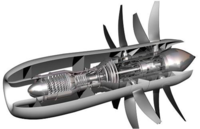
Propulsion & Energy
Propulsion & Energy

Mission
The mission of Propulsion & Energy Division (P&E) is to cultivate the next generation of propulsion engineers and to advance the state of the art in energy systems analysis through innovative methods that incorporate thermodynamic analysis, component analysis, and novel design ideas.
Functions
P&E is focused on design for subsonic, supersonic, and VTOL propulsion systems as well as component design and analysis for all types of energy and thermal systems with application to aerospace and ground power. Its core functions include:
- Aerothermo-mechanical Design
- Terrestrial Power Systems
- Subsystems & Aeropower
- Electrification
- Fuels & Emissions
- Controls & Operability
Activities

- Other major focuses for P&E are systems analysis and propulsion technology assessments at the conceptual design level with a major focus on electric and hybrid electric and other sustainable aviation technologies.
- P&E does work in optimized and sustainable energy systems for both ground power and aerospace applications, including the development of models for all components of an aircraft’s energy system.
- Researchers within P&E develop capabilities in aerothermodynamic cycle analysis for all types of gas turbine engines, thermal management systems design, inlet and nozzles, turbomachinery design, fuel systems and cryogenics, electric systems, and a number of other related components.
- To support its propulsion system design functions, P&E maintains the following tools:
- Georgia Tech Hybrid Electric Analysis Tool (GT-HEAT), which is used for hybrid and electric aircraft designs
- Electrified Propulsion Architecture Sizing and Synthesis (EPASS), which is used to develop electric, hybrid electric, and sustainable fuel propulsion system models for the EDS tool
- One of the newer priorities for P&E is to help tackle the sustainability challenge through collaboration with the Advanced Configurations Division to create new and novel propulsion system ideas for future ASDL concepts of the 21st century.
Team
- Jon Gladin, Division Chief
- Yu Cai
- Russ Denney
- James Kenny
- Metin Ozcan
- Jiacheng Xie
